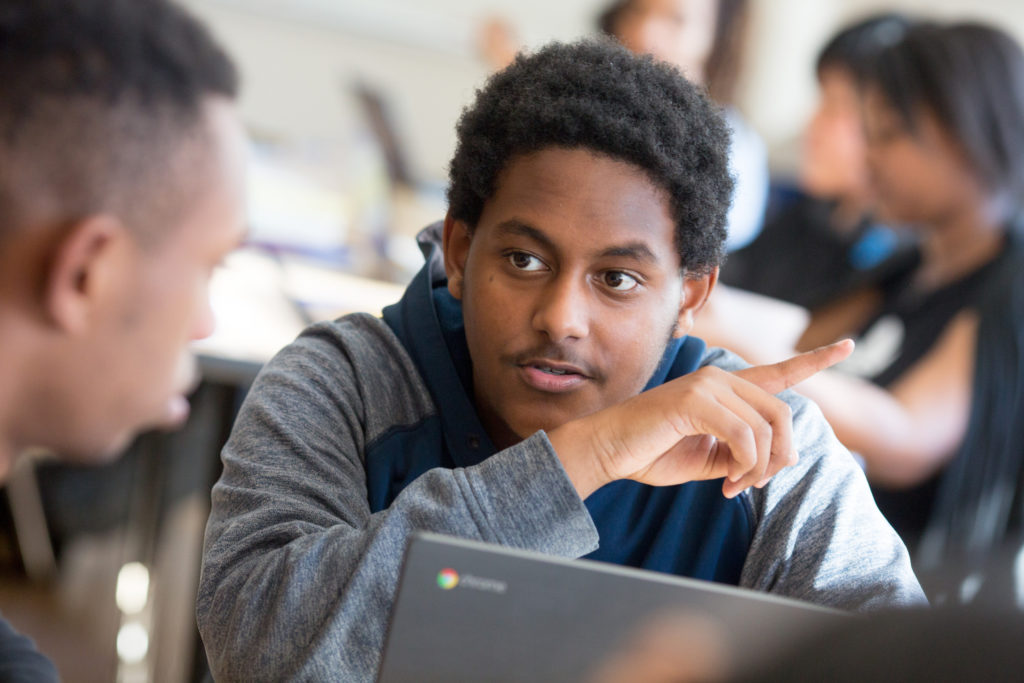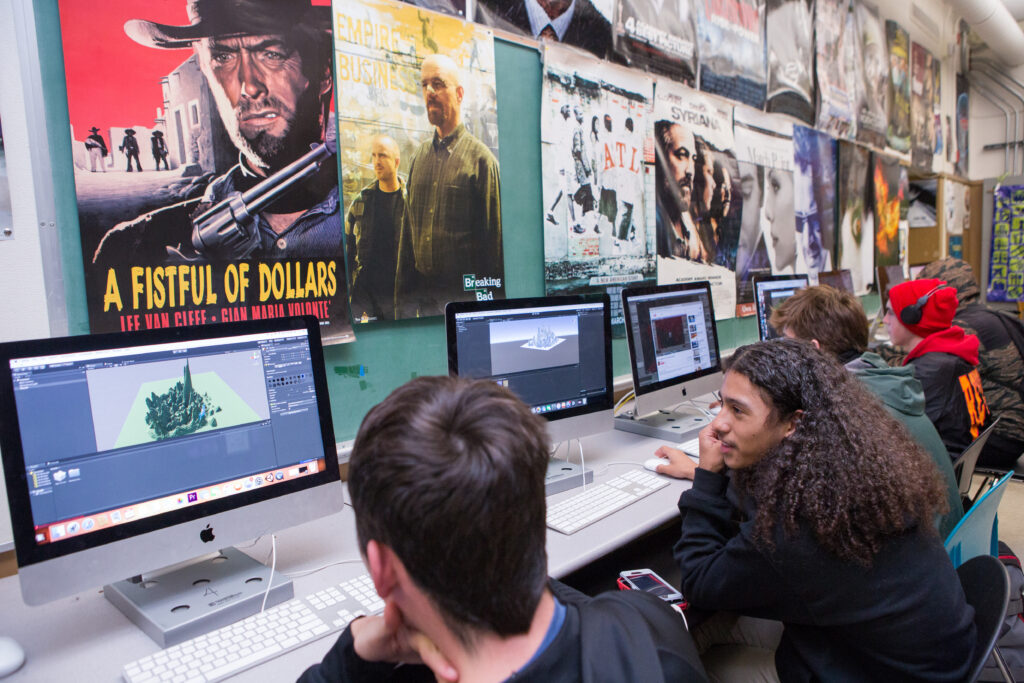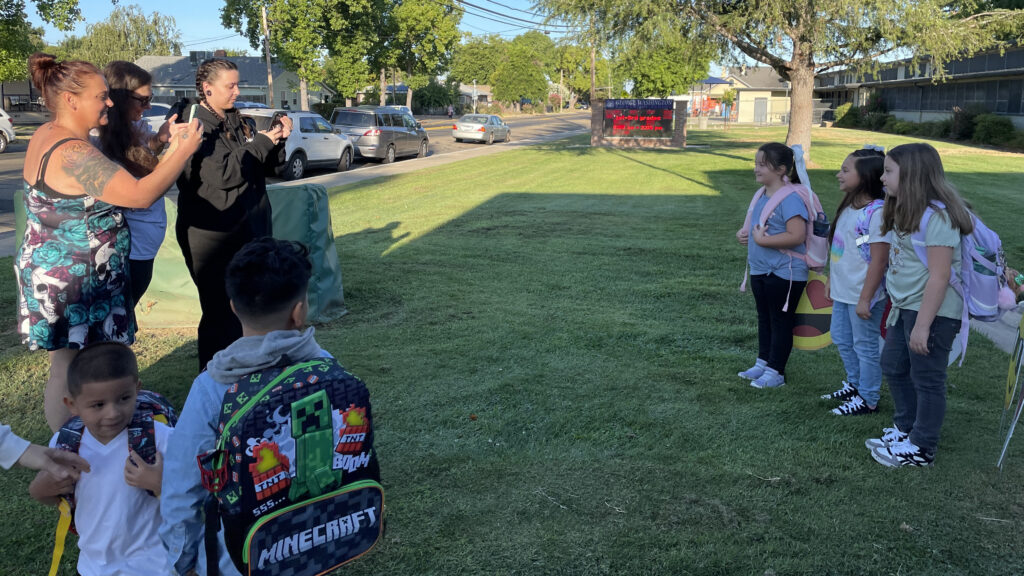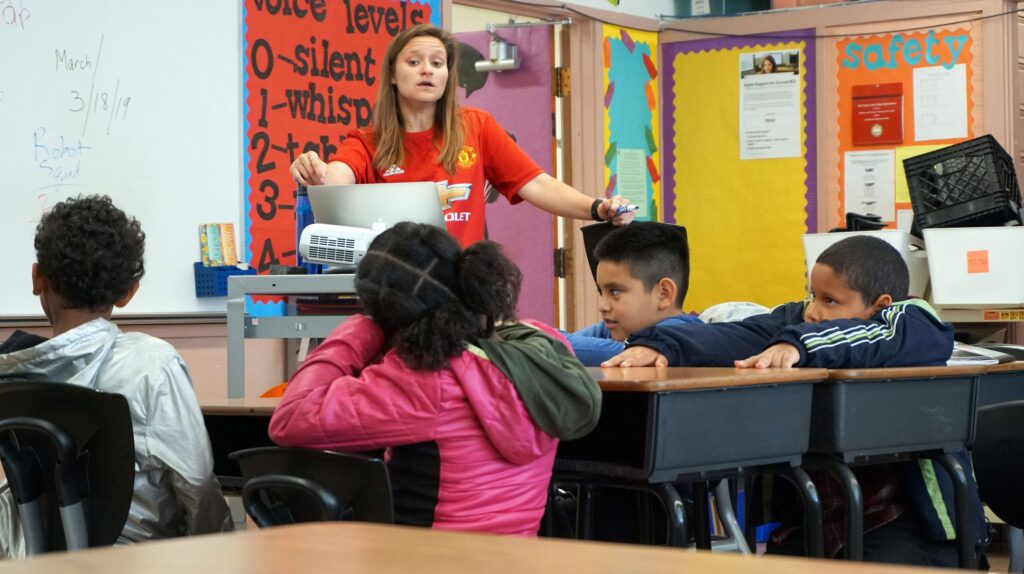
A special education class at West Contra Costa Unified’s Stege Elementary School in Richmond.
Credit: Andrew Reed / EdSource
TOP TAKEAWAYS
- Federal cuts are directly impacting programs designed to support students with disabilities in their transition to adulthood and programs that train special education teachers.
- These cuts have caused significant concern from advocates and educators for disabled students.
- Regional special education administrators in California are calling on Congress to rescind the cuts and for the state to fill the gap in the meantime.
Jake, a 17-year-old junior, is beginning to think about life after he graduates from Mt. Carmel High School in San Diego County.
This is a daunting task for any teen, but his mother, Angela, says it’s been especially thorny for Jake, who is on the autism spectrum, has attention-deficit hyperactivity disorder (ADHD) and struggles with anxiety.
The prospect of getting a job one day soon has made him “suicidal,” said Angela, who asked not to share her family’s last name to protect her son’s privacy about his diagnoses. She said her son has told her, “I’m going to be homeless; I won’t get a job.”
So Angela was thrilled when Jake was accepted into a new program at his school, Charting My Path for Future Success, which helps students with disabilities navigate into adulthood. In late January, Jake began to meet with a caseworker who seemed to understand his needs. At the time, Angela thought, “My prayers have been answered,” she said.
That changed on Feb. 12, when Jake’s school district, Poway Unified, received a notice that the Trump administration had cut funding for the grant behind Charting My Path for Future Success.
“We don’t have a clear understanding of why this decision was made or why this particular grant program was cut so suddenly,” said Stacey McCrath-Smith, director of special education at Poway Unified. “It was very upsetting to our staff. It was hard to explain to families and parents.”
An email from the U.S. Department of Education said the grant was “deemed to be inconsistent with, and no longer effectuates, Department priorities.” Representatives from the department did not respond to questions from EdSource.
Educators and disability advocates in California are raising the alarm about federal cuts that are already affecting programs that support students with disabilities. That includes research like Charting My Path for Future Success, but also cuts to special education teacher training.
The disability advocacy community is in defense mode, said Robyn Linscott, director of education and family policy for The Arc, a national advocacy group for people with intellectual and developmental disabilities.
“There are many, many pieces that we’re concerned about,” Linscott said.
Linscott and other advocates for disabled students worry that other Trump administration proposals, such as dismantling the U.S. Department of Education and cutting Medicaid, could further harm disabled students. But some cuts have already taken effect.
The morning after the district was told its grant funding was cut off, Poway Unified notified four teachers being trained to help disabled teens transition to adulthood that they would immediately be reassigned to other positions in the district. This is despite early signs of success, such as one nonverbal student who had become highly engaged in sessions about career planning in a way he had never been in academic classes, McCrath-Smith said.
Jake will no longer receive training to help prepare him for college and employment. Now he will not receive mentoring or lessons on goal-setting, finding an apartment and other skills. His mother said he struggles with real-world topics like banking or how a resume works. She’s been looking for alternatives, but is unsure how her son will find help for his unique needs.
“It was like a gut punch,” Angela said.
Educators’ worries extend beyond the 420 students in California, including students at Sweetwater Union High and Mt. Diablo Unified school districts, who were a part of the national study.
“The recent and abrupt elimination of critical funding and research developments will significantly impact important ongoing special education research and services to students, not only in our member [local education agencies], but in others who would ultimately benefit from the results of their research,” according to a letter written on behalf of the SELPA (Special Education Local Plan Area) Administrators of California, California County Superintendents, the Coalition for Adequate Funding for Special Education and the three districts hit by the cuts.
The March 21 letter calls on Congress to compel the U.S. Department of Education to reverse its decision, and for the California Legislature to bridge the immediate funding gap of $2.8 million for this “vital” special education research.
A lawsuit filed on behalf of researchers against the U.S. Department of Education this month challenged whether the executive branch has the constitutional power to cut nearly $900 million from the Institute of Education Sciences. The suit called the department’s actions “dramatic, unreasoned and unlawful,” noting that the canceled grants left students with disabilities “in the lurch, with no time or help to even transition out of the Charting My Path Program.”
Cuts to special education teacher training
The Trump administration also abruptly terminated $600 million in federal teacher training grants, including programs to address the acute shortage of special education teachers who work with California’s nearly 840,000 students with disabilities.
Three SELPAs in the state reported losing funding to create a pipeline of special education teachers, according to a March 25 letter sent to California state and federal legislators on behalf of the affected districts, SELPA Administrators of California and California County Superintendents.
Under these cuts, the Tulare County SELPA reported that it will lose about $10 million, San Diego’s South County SELPA will lose $4.1 million and the West San Gabriel SELPA will lose up to $650,000. Those cuts are in limbo now as they’re also being challenged in court.
Teacher shortages can impede the education of students with disabilities, said Tamara Schiern, executive director of the West San Gabriel Valley SELPA. When districts are unable to fill openings for these positions, they either hire teachers who are not fully credentialed or long-term substitutes.
According to a federal survey, there’s both a state and nationwide shortage of teachers with the appropriate special education credentials, with 40% of districts reporting in 2020-21 that they struggled to staff special education roles.
The West San Gabriel Valley SELPA typically has 30 vacancies to fill each year in its 14 districts, and it would struggle to find credentialed teachers for eight to 12 of them, Schiern said.
In one example, Schiern said a string of long-term substitute teachers was covering a class of elementary school students with autism. Parents complained, and then the district, which she declined to disclose, asked the SELPA for help. The agency was able to help set the classroom up and model instructional strategies, but when a new substitute teacher came in, the agency had to start from scratch again.
“That’s what a teacher shortage looks like on the ground,” Schiern said.
This is why the West San Gabriel Valley SELPA began a program to train teacher residents specifically in special education. Funding came from state and district sources, but districts with high-need students received federal reimbursement for their share. This year, the program supported 27 teacher residents; ultimately, the goal was to cover 40 residents.
But federal cuts to the Teacher Quality Partnership Grant mean that the annual stipend for the residents will be slashed from $37,000 to $27,000; the coordinator for the program was cut, and only half the number of teacher residents can be supported, Schiern said.
In the meantime, the letter from special education administrators and superintendents asks California’s congressional delegation to pressure the U.S. Department of Education to reinstate the funding and the state legislators to cover the $14.9 million shortfall.
“The sudden loss of federal funding for teacher residency grant programs will have a significant and profound impact on an already fragile system,” reads the letter.
The San Gabriel Valley is a community that is ethnically and racially diverse, with a large population of immigrants and English learners. The region’s SELPA looks to parents and paraprofessionals to recruit special education teachers who can reflect that demographic diversity, Schiern said, adding that representation matters in education for both students and parents — a point backed by research.
This made the program attractive for California to fund, but it also may have made the program a target for the Trump administration, which has canceled contracts for programs that promoted diversity, equity and inclusion.
“I can’t help but feel that that could be part of the issue,” Schiern said. “A lot of what California does is at odds with the federal government right now.”
We want to hear from you
A new administration always brings change, and education is once again at the center of the national conversation. As we track these developments, we want to hear from you. What policies are you interested in reading about? What questions do you have about how federal decisions might shape education in California? How will this change affect disabled students in California?
Your input will help inform our coverage.














